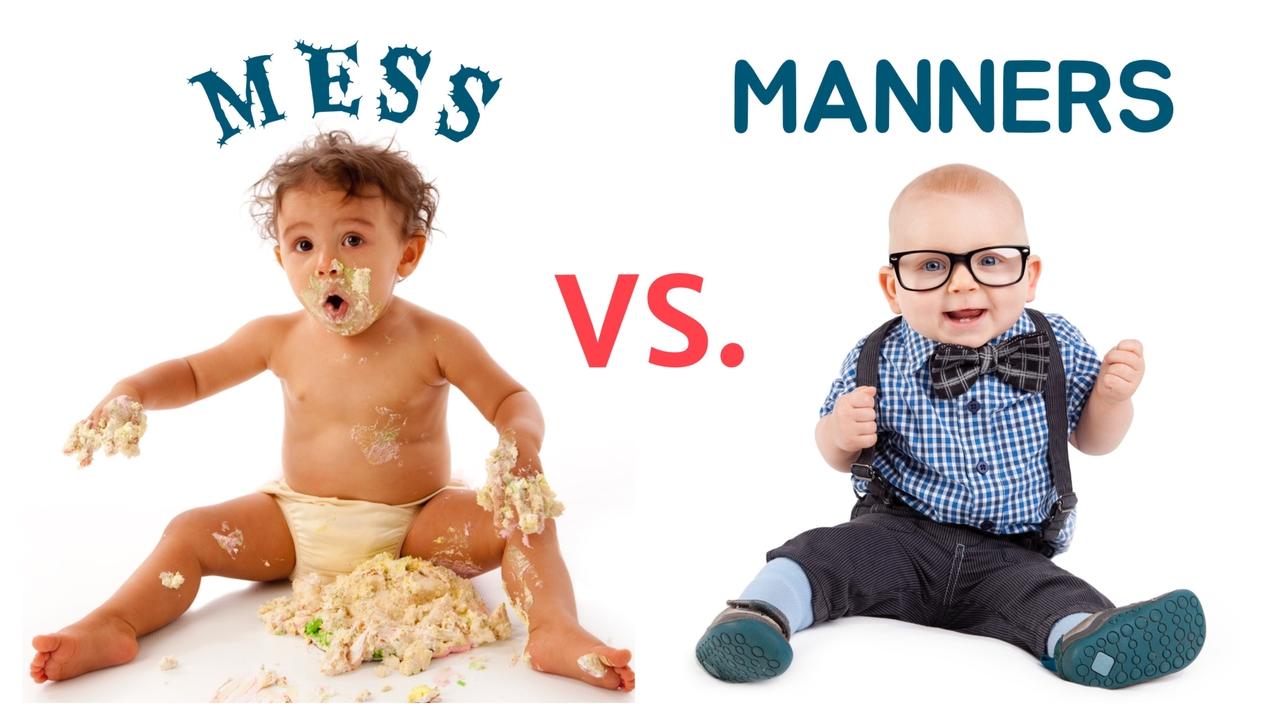
Mealtime Mess vs. Manners
“I hate the mess at meals.”
“I have a real problem with messiness.”
“Her grandparents won’t allow it.”
“My husband can’t stand the mess.”
“Mess teaches bad manners.”
These are common responses from parents when I tell them that I want them to let their baby (or toddler) get good and messy during mealtimes. You know…squish banana between their little fingers, rub tomato sauce through their hair, poke/prod and roll peas, watch mashed potatoes go splat and giggle as carrots bounce off the kitchen floor.
Simply put…mess is best. Children learn to eat and accept new foods if they are provided with opportunities to get messy. Eating is an experience that engages all of our 5 senses: touch, smell, tastes, sight, and sound. Kids that are encouraged to explore food and get messy tend to be less picky and more likely to eat a variety of foods and textures. Messy mealtimes foster independence by providing opportunities for children to learn about self-feeding by touching food and bringing it toward their mouth. Mess = independence = self-feeding = positive mealtimes!
Mess trumps manners when kids are learning to eat. Kids need to learn to eat first, then learn manners later.
I frequently tell my clients (and show pictures as proof...see below) about how I let my 2 children get covered in food during mealtimes when they were learning to eat. I assure parents that my kids were encouraged to get messy during feedings when they were little; however, they have grown into well-mannered young adults that no longer rub their mashed potatoes into their hair.
Proof...my kids!
10 Hacks for Messy Mealtimes:
1. Don’t bathe your little one right before mealtimes. Wait until the end of the day. Parents get very frustrated when their child gets messy during meals when they have just given him/her a bath.
2. Strip your child down to their diaper at feeding times. Avoid feeding him/her in a favourite outfit as this will just increase parental stress.
3. Use a splat-mat under the high-chair to make the clean-up easier. You can buy feeding mats or make your own. I usually suggest that parents use newspapers, an old sheet, or a plastic tablecloth from the dollar store.
4. Remember that it’s normal for kids to experiment with cause and effect and the rules of gravity (e.g., dropping food and watching it splat on the floor). This is part of your child’s learning and development.
5. Remove your attention if your child is throwing food. Do not pick food up off the floor as this becomes very entertaining for curious little ones. Ignore food that is thrown and clean it up with no comment at the end of the meal. Provide attention like smiling, talking, and modeling eating when your child is demonstrating behaviours like touching, smelling, or eating foods.
6. If your child is just throwing food or pouring out his/drink at mealtimes calmly remove the food/liquid. Tell your child what to do versus what not to do:
“Food stays on the tray.”
“Cups are for drinking.”
7. If your child is throwing foods, introduce an all-done bowl. When your child throws food items, use hand-over-hand assistance and model placing the food in the bowl. Say, “all done.” Follow-up with praise to reinforce this behaviour.
8. At clean-up time, take your child out of the highchair and bring him/her over to the kitchen sink. Run lukewarm water and gently wash their face, hands, and chest using your hands. You can sing a clean-up song. Let your child splash in the water while you clean him/him using your hand as skin-to-skin contact.
9. The Aftermath: When my kids were young, messy little eaters I would take the highchair into the backyard after feedings and spray it down with the garden hose and leave it in the sunshine to dry.
10. If grandparents or other family members are resistant to mess, blame it on your feeding therapist! I always tell parents to take the heat off themselves when answering to family members and let them know that allowing their child to get messy has been recommended as part of the feeding therapy program to help him/her learn to eat.
 Please don't...
Please don't...
- Scrape your child's messy face with a utensil to clean during feedings.
- Wipe your child's face throughout the feeding (it's ok to wipe food from eyes).
- Wipe the tray throughout the feeding.
- Wipe your child's hands repeatedly during the feeding.
- Make disgusted faces when looking at your child covered in food.
I encourage you to embrace the mealtime-mess and worry about manners later, as your child gets older. Every week, my clients send me awesome pictures of their kids covered in food while learning to eat…nothing makes me happier than a good mealtime mess. Sensory exploration of food allows your little eater to learn about how food looks, feels, sounds, smells, and tastes. Nicola says, “Every mess can be cleaned-up”…messes are easier to deal with than picky eating and feeding aversion...so try to enjoy the journey toward eating, not the destination.
Feel free to share pics of your messy little one during feedings to my FeedingPlus Facebook Page!



